健康的社会决定因素与青少年慢性疼痛。
IF 2.2
3区 医学
Q2 INTEGRATIVE & COMPLEMENTARY MEDICINE
引用次数: 0
摘要
目的:确定美国青少年(指儿童和青少年)健康的社会决定因素 (SDOH) 与慢性疼痛之间的关系:确定美国青少年(指儿童和青少年)健康的社会决定因素(SDOH)与慢性疼痛之间的关系:方法:从 2022 年全国儿童健康调查(National Survey of Children's Health)中获取包括美国全国青少年样本在内的数据。其中包括五个 SDOH 相关领域(即经济稳定性、社会和社区环境、邻里和建筑环境、医疗保健的获取和质量,以及教育的获取和质量)中的 20 个指标。是否存在慢性疼痛是通过一个自我报告的问题进行评估的,由主要照顾者回答。采用多变量逻辑回归模型估算了SDOH相关指标与青少年慢性疼痛之间的关系,同时对协变量(如年龄、性别、种族、体重状况和运动行为)进行了调整:收集了 30,287 名 6-17 岁美国青少年的数据(年龄中位数 [SD] 为 11.59 [3.30] 岁;14,582 名女孩 [48.97%])。在最终样本中,有 7.5% 的照顾者表示自己患有慢性疼痛。青少年在不同的 SDOH 条件下成长,包括食物不足(OR = 1.46,95 % CI:1.01 至 2.10)和父母失业(OR = 1.56,95 % CI:1.15 至 2.12);学校参与度低(OR = 1.48,95 % CI:1.14 至 1.92)和学校安全系数低(OR = 1.65,95 % CI:1.14 至 2.39);获得优质医疗保健的机会有限(OR = 2.56,95 % CI:2.12 至 3.09),医院就诊频率高(OR = 4.76,95 % CI:1.82 至 12.44)和替代性医疗保健(OR = 2.57,95 % CI:2.07 至 3.20);遭受欺凌(OR = 1.37,95 % CI:1.11 至 1.68)和基于社区的不良童年经历(OR = 1.64,95 % CI:1.32 至 2.05);以及不利的便利性特征(OR = 1.38,95 % CI:1.05 至 1.79);导致出现慢性疼痛的几率更高:结论:SDOH 领域中的不同指标与美国青少年出现慢性疼痛的几率较高有关。这些发现暗示了SDOH与青少年慢性疼痛之间的关系,需要采取综合方法来解决健康公平问题,以预防和减少青少年慢性疼痛的出现。本文章由计算机程序翻译,如有差异,请以英文原文为准。
Social determinants of health and youth chronic pain
Objectives
To identify the relationships between social determinants of health (SDOH) and chronic pain among U.S. youth (referring to children and adolescents).
Methods
Data including a national sample of U.S. youth were retrieved from the 2022 National Survey of Children's Health. Twenty indicators within five SDOH-related domains (e.i., economic stability, social and community context, neighborhood and built environment, health care access and quality, and education access and quality) were included. The presence of chronic pain was assessed using a self-reported question, answered by the main caregiver. Associations of SDOH-related indicators and youth chronic pain were estimated using multi-variable logistic regression models, while adjusting for covariates (e.g., age, sex, ethnicity, weight status, and movement behaviors).
Results
Data from 30,287 U S. youth aged 6–17 years (median [SD] age, 11.59 [3.30] years; 14,582 girls [48.97 %]) were collected. In 7.5 % of the final sample size, caregivers reported that they had chronic pain. Youth grow up in conditions with diverse SDOH profiles, including food insufficiency (OR = 1.46, 95 % CI: 1.01 to 2.10) and parental unemployment (OR = 1.56, 95 % CI: 1.15 to 2.12); low school engagement (OR = 1.48, 95 % CI: 1.14 to 1.92) and low school safety (OR = 1.65, 95 % CI: 1.14 to 2.39); limited access to quality health care (OR = 2.56, 95 % CI: 2.12 to 3.09), a high frequency of hospital visits (OR = 4.76, 95 % CI: 1.82 to 12.44), and alternative health care (OR = 2.57, 95 % CI: 2.07 to 3.20); bullying victimization (OR = 1.37, 95 % CI: 1.11 to 1.68) and community-based adverse childhood experiences (OR = 1.64, 95 % CI: 1.32 to 2.05); and disadvantageous amenity characteristics (OR = 1.38, 95 % CI: 1.05 to 1.79); resulted in higher odds of presenting chronic pain.
Conclusions
Different indicators included in the SDOH domains were associated with a higher probability of presenting chronic pain in U.S youth. These findings have implied relationships between the SDOH and chronic pain in youth, requiring a comprehensive approach to addressing health equity to prevent and reduce the presence of youth chronic pain.
求助全文
通过发布文献求助,成功后即可免费获取论文全文。
去求助
来源期刊

Complementary Therapies in Clinical Practice
INTEGRATIVE & COMPLEMENTARY MEDICINE-
CiteScore
6.30
自引率
6.70%
发文量
157
审稿时长
40 days
期刊介绍:
Complementary Therapies in Clinical Practice is an internationally refereed journal published to meet the broad ranging needs of the healthcare profession in the effective and professional integration of complementary therapies within clinical practice.
Complementary Therapies in Clinical Practice aims to provide rigorous peer reviewed papers addressing research, implementation of complementary therapies (CTs) in the clinical setting, legal and ethical concerns, evaluative accounts of therapy in practice, philosophical analysis of emergent social trends in CTs, excellence in clinical judgement, best practice, problem management, therapy information, policy development and management of change in order to promote safe and efficacious clinical practice.
Complementary Therapies in Clinical Practice welcomes and considers accounts of reflective practice.
 求助内容:
求助内容: 应助结果提醒方式:
应助结果提醒方式:


